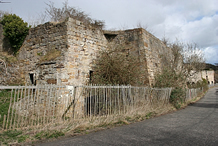Charlestown, Fife, Scotland |
|
|
|

LimeKilns at Charleston © Copyright Anne Burgess and licensed for reuse under the Creative Commons Licence.
Charlestown in 1846, a village and small sea-port, in the parish and district of Dunfermline, county of Fife, 3 miles (S. W. by S.) from Dunfermline; containing 772 inhabitants. This village, which is situated on the north shore of the Firth of Forth, was founded for the accommodation of the persons employed in the extensive collieries and lime-works of the Earl of Elgin, in the immediate neighbourhood. It is well built, and has a neat and pleasing appearance; the surrounding scenery is enlivened by the well-planted demesne of Broomhall, the seat of the earl, and the inhabitants are generally in easy circumstances. The manufacture of various articles of cast-iron and brass, for which a foundry has been established, is carried on to a moderate extent; and there are some extensive limekilns, in which the limestone obtained from the quarries is burnt. The produce of the Elgin collieries, and the limestone from the quarries, are conveyed by railways from the mines, to the harbour here, for exportation; the quantity of coal shipped annually, is estimated at 120,000 tons; of limestone, 15,000 tons, and of shell-lime, about 400,000 bushels. The harbour is spacious, and has been deepened and greatly improved within the last few years, and great facility of communication has recently been afforded by the erection of a wooden pier, for the steamboats plying in the Frith, which touch at this place. A school is |
Limekilns, Fife, Scotland |
|
|
|
Is built around a large square courtyard dominated by a rectangular tower house that most likely built by John de Crichton in the late 14th century.

Limekilns, a village in Fife, Scotland, lies on the shore of the Firth of Forth. Unlike the neighbouring village of Charlestown, Limekilns is an extremely old settlement dating back to the 14th century. Limekilns, a village, and sea-port, in the parish and district of Dunfermline, county of Fife, 3 miles (S.) from Dunfermline; containing 949 inhabitants.
This place, which was formerly considerable for its trade, appears to have been of some note at an early period.
The oldest building in the village is without doubt The King's Cellar, a large and somewhat mysterious property whose existence can be traced back to 1362. It has served many different purposes throughout its long life, notably as a store house, school, library and chapel. It is currently employed as a Freemasons Lodge and is generally not open to the public.
In it most probably were stored the various articles imported for the use of the royal household in the palace of Dunfermline, and on which is the date 1551.
The village is situated upon the north shore of the Firth of Forth, and is neatly built. The inhabitants are chiefly employed in the neighbouring lime-works, and in the exportation of coal, lime, wool, and other produce, in which several vessels belonging to the port are engaged. Ship-building, and the curing of fish, are also carried on to a moderate extent.
The harbour, which is accessible to vessels of 300 tons' burthen at spring-tides, is spacious and commodious; and the several shipowners here were incorporated as an Insurance Company, by act of parliament, in 1834. There is a ferry to Blackness; and the steamboats to and from Stirling touch at the port. A merchant-seamen's fund has been established.
There is a place of worship for the United Associate Synod; and a school for females is held in a room over the King's Cellar.
The exact origins of the name Limekilns are unknown. Certainly lime was burned there in relatively small amounts in the early life of the village, though there was a much larger operation going on in the neighbouring village of Charlestown. The ruins of the massive kilns still exist today and are protected by the National Trust for Scotland.
In its early days Limekilns was mainly a fishing village, with the large natural harbour providing docking facilities for small to medium transport and cargo ships. Soap was also produced from a soapworks located near Caupernaum Pier.
However, the years of industrial decline meant that most of these industries were lost and Limekilns became just another sleepy coastal village.
New housing estates were added during the property boom of the 1970s and 1980s, considerably boosting the size and population of the village.
Today, its picturesque location and generally high quality housing make Limekilns an attractive residential area. Limekilns is presided over by the Earl of Elgin, who lives in Broomhall House overlooking the village. |

 ©peh
©peh
